From a business perspective, what's the most critical stage in a customer journey?
The first interaction? The part where they start taking an interest in your offering? Or when they fill in their details to become prospects? To be honest, none of that!
The most crucial stage in any customer journey for a business is the purchase. The moment a customer finally makes the payment and checks out from your site, store, or app. It's not just critical because it gives your revenue; it's also crucial because it sets the tone for future business flow and your ongoing customer relationship.
In this blog, we will delve into the world of post-purchase surveys and explore how you can effectively implement them as a part of retail feedback to refine the shopping experience, drive growth, and deliver maximum customer satisfaction.
TL;DR
- What: Short surveys sent after the purchase, gathering valuable feedback on the buying experience.
- Why: Improve conversions, boost customer satisfaction, optimize product/service, personalize marketing.
- Top questions: Overall experience, product features, purchase process, customer service, intent to repurchase.
- Best practices: Keep it short, personalize questions, send at the right time, offer incentives, analyze & act.
- Channels: Email, website pop-ups, SMS, in-app messages, phone calls.
- Zonka Feedback offers an out-of-the-box post-purchase survey template that you can use to gauge feedback once your customers have purchased from you. You can even create a survey from scratch or edit the template to customize it as per your industry. Schedule a demo to understand the tool better.
Fuel Business Growth with Customer Feedback 🔥
Collect real-time, in-moment feedback at all touchpoints in customer journey and leverage feedback insights to transform customer experience.

What are Post Purchase Surveys?
Post-purchase surveys are valuable tools businesses use to gather feedback from customers after they've made a purchase. Think of them as a conversation you have with your customers to understand their experience and how you can improve.
They come in different formats but typically consist of short, engaging questions presented through various channels like:
- On the thank you page: Immediately after checkout, a pop-up or embedded survey captures quick feedback about the purchase process.
- Via email: A few days later, an email with a link to a more detailed survey delves deeper into customer satisfaction and product/service experience.
- SMS: For mobile-focused businesses, short surveys sent via text message can be a quick and convenient way to get feedback.
Why Should Businesses Take Post Purchase Feedback?
There are several reasons why businesses incline towards collecting feedback from their customers once they've made a purchase with them.
Here's why listening to your customers after they buy is just as crucial as pre-purchase engagement:
- Boost conversions: Identify factors preventing purchases and optimize accordingly.
- Refine product/service: Gain valuable insights for product development and feature adjustments.
- Personalize marketing: Segment customers based on feedback and tailor future communications.
- Increase lifetime value: Build stronger relationships and encourage repeat purchases.
- Improve customer experience and satisfaction: By identifying pain points and areas for improvement, you can refine your product/service offering and enhance the customer journey.
- Boost customer loyalty: Happy customers are more likely to become repeat buyers and recommend your brand to others.
- Make data-driven decisions: Insights from surveys provide valuable data to guide your marketing strategies, product development, and overall business operations.
- Increase conversion rates: Understanding customer motivations and addressing their concerns can help you optimize your checkout process and attract more customers.
The insights gathered from a post-purchase survey can be used effectively to improve the product, experience, service, or even its overall marketing including for businesses that sell luxury items like Rolex watches. For instance, you can ask them about the relevance of information around the product, the check-out process, the delivery process, decision factors, product quality, and more to identify areas of improvement.
If you are looking at getting customer feedback after they have purchased your product or service, here is a post-purchase survey template that can be added to your website or in-app and product.
Post-Purchase Survey Questions to Enhance Customer Experience
A post-purchase survey allows you to gather feedback on various touchpoints of the customer journey, including the purchasing process, product usage, and overall customer satisfaction. By understanding and addressing customer experience through post-purchase surveys, you can strengthen customer relationships and drive long-term success for your business.
#1. Post Purchase Survey Questions to Collect Pricing Feedback
The pricing strategy of your product can be a deal breaker for most of your customers. Adding post-purchase survey questions on pricing is essential in assessing the perceived value and affordability of the products or services, which is crucial for maintaining a competitive edge in the market. Customers' feedback can shed light on whether the pricing aligns with their expectations and whether they believe it accurately reflects the quality and value they receive.
Here are some eCommerce or retail survey questions on pricing that you can consider adding to your post-purchase survey.
- How would you rate the value for money of the product/service you purchased?
- Did you find the pricing of the product/service reasonable?
- How satisfied are you with the pricing options available for the product/service?
- Did you perceive the product/service to be worth the price you paid?
- How would you rate the affordability of the product/service?
- Did you encounter any challenges or confusion regarding the pricing details?
- Were there any hidden costs or unexpected charges associated with the purchase?
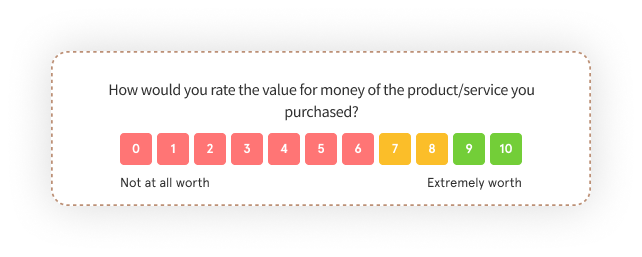
#2. Post Purchase Survey Questions on the Delivery Process
To uncover any challenges or bottlenecks in their delivery process or enhance the efficiency and reliability of delivery operations, you need customer feedback on delivery concerns like late deliveries, damaged packages, or poor communication. Feedback collected through post-purchase surveys on the delivery process provides you with valuable insights to optimize your logistics and delivery operations. You can also embed survey in email or can send SMS surveys for delivery feedback. It can help you recognize opportunities for streamlining processes, reducing delivery costs, and enhancing overall operational efficiency to stay competitive.
Here are some post-purchase survey questions that can make the delivery process more effective.
- How satisfied are you with the timeliness of the delivery of your order?
- Did the delivery of your order meet your expectations in terms of speed and efficiency?
- Were you provided with clear and accurate tracking information for your shipment?
- How would you rate the packaging of your order in terms of protection and presentation?
- Did you experience any issues or delays during the delivery process?
- Were you notified on time about any changes or updates regarding your delivery?
- Were there any difficulties or challenges with receiving your order?
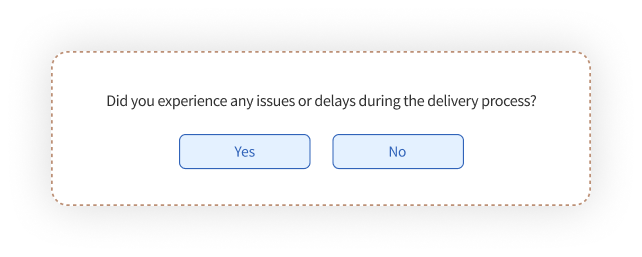
#3. Post Purchase Survey Questions on Product Quality
What sets you apart from your competitors is your unwavering commitment to product quality. Including questions about quality in post-purchase surveys helps measure customer satisfaction levels related to the product your customers received. Collecting product feedback can help assess it on different parameters and identify areas loved by your customers or where it can be improved. Post-purchase surveys allow you to proactively address quality concerns, rectify issues, and maintain a positive brand image, thereby driving customer loyalty.
Here are some post-purchase survey questions on the product quality that you can add to your survey.
- How satisfied are you with the overall quality of the product you purchased?
- How would you rate the durability of the product?
- Did the product meet your needs and requirements?
- Were there any defects or issues with the product upon receiving it?
- Would you consider purchasing similar products from our company based on the quality of this product?
- How likely are you to recommend the product based on its quality?
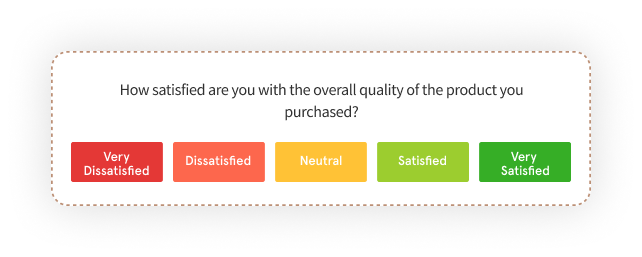
#4. Post Purchase Survey Questions on Shopping Experience
Post-purchase surveys provide an opportunity for customers to share their overall shopping experience, including factors such as website navigation, product selection, checkout process, and any other aspects of the purchasing journey. Whether you are asking eCommerce survey questions or collecting retail store feedback, these questions would help assess the experience that the shoppers had while buying from you. By asking questions about the shopping experience, you can gather specific feedback on what worked well and what could be improved and uncover opportunities to streamline the processes, eliminate barriers, and optimize the customer experience.
Consider including these questions in your post-purchase survey to understand your customer's shopping experience.
- How would you rate your overall shopping experience with our company?
- Were you able to easily find the products you were looking for?
- How would you rate the user-friendliness of our website/store interface?
- Did you encounter any issues or difficulties during the checkout process?
- Were the product descriptions and images clear and helpful in making your purchasing decisions?
- How satisfied are you with the variety and selection of products available?
- How would you rate the ease of browsing and navigating through our website/store?
- Did you experience any technical issues or glitches while shopping?

#5. Post-Purchase Survey Questions on Purchase Decision Factors
Various factors influence purchase decisions, and gaining insights into customer preferences can help you understand what resonates well with your customer. Post-purchase survey questions on decision factors can help you find answers to what drives customers to choose your brand over competitors, what they expect in your product, and how you can personalize your offerings. Here are some survey questions based on the same.
- What key factors influenced your decision to purchase from our company?
- How important were price and affordability in your purchase decision?
- What role did product features and specifications play in your decision-making process?
- Did positive customer reviews and ratings influence your decision to purchase?
- Did recommendations from friends, family, or colleagues impact your buying decision?
- Did product customization options or personalization influence your decision to make a purchase?
- Were there any specific promotions, discounts, or incentives that influenced your purchase decision?
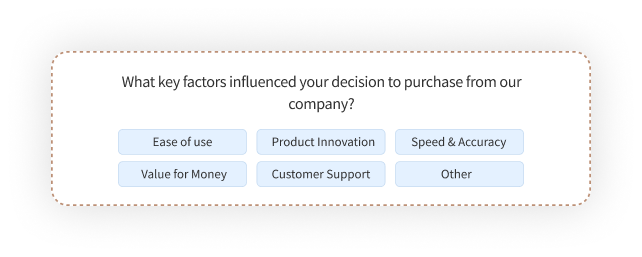
#6. Post Purchase Survey Questions on Brand Perception and Loyalty
By including questions on brand perception, such as brand reputation, quality, and values, you can gain insights into how customers view your brand. By aligning your messaging, marketing efforts, and customer interactions, you can strengthen your brand image. Consider these questions to add to your post-purchase survey on brand perception and loyalty.
- How familiar are you with our brand?
- How would you rate your overall perception of our brand?
- How likely are you to recommend our brand to others?
- How likely are you to repurchase products/services from our brand in the future?
- How does our brand compare to competitors in terms of innovation and uniqueness?
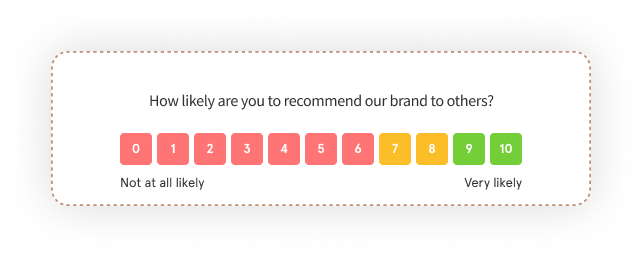
#7. Post Purchase Survey Questions on General Feedback and Suggestions
Seeking customer feedback is one of the best ways to demonstrate a customer-centric approach. Inviting customers to provide general feedback and suggestions empowers them to actively participate in shaping the product or service. They often have unique perspectives that can uncover hidden opportunities for improvement. Here are some questions to seek customer feedback for a post-purchase survey.
- How satisfied are you with your overall purchase experience with our company?
- Is there anything specific that you particularly liked about your shopping experience with us?
- Is there anything in particular that we could improve upon in our products or services?
- Did you encounter any challenges or difficulties during the purchasing process?
- Do you have any suggestions for new products or services you would like us to offer?
- How likely are you to recommend our company to others based on your experience?
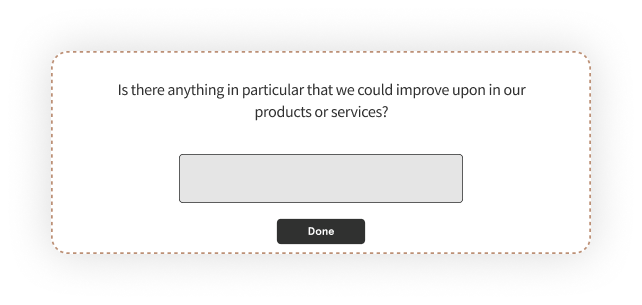
Post-purchase Survey Examples & Use Cases
There are different scenarios in which businesses use post-purchase surveys. Whether they are industry based or based on the type of offerings one has or the business model, using surveys post-purchase can help gauge feedback about the experience, satisfaction, and other aspects of the business.
Here are some post-purchase survey examples with sample questions:
1. eCommerce
Using post-purchase surveys for your eCommerce store can help understand product satisfaction, purchase experience, and potential for future purchases. Here are some questions you can ask:
- How accurate were the product descriptions and images?
- Did the product live up to your expectations?
- How easy was the checkout process?
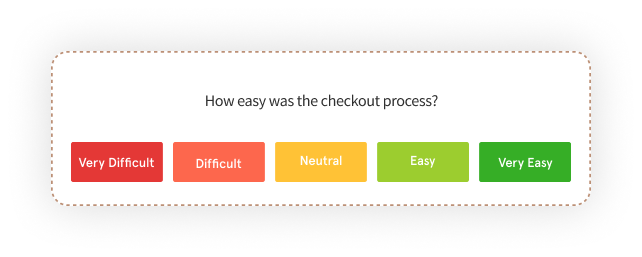 2. Retail Stores
2. Retail Stores
You must've seen those kiosks or executives with tablets asking for feedback at different stores once you've purchased a product from them. These are the best examples of post-purchase surveys as they help assess customer service, store layout, and product selection in real time.
Here are some questions generally asked at retail stores after a purchase is made:
- Would you shop here again, and what could we do to improve your experience?
- How helpful were the staff?
- Was the store layout easy to navigate and find what you needed?
- Were you satisfied with the variety and quality of available products?
- Are there any brands or products you wish we carried?
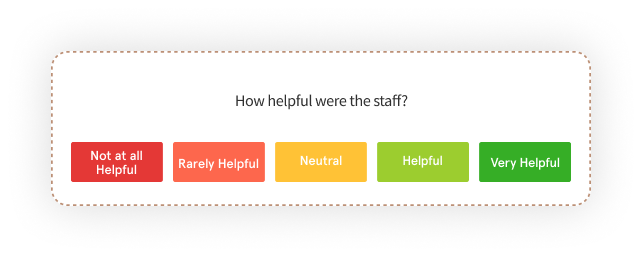 3. Subscription Services
3. Subscription Services
For several SaaS products or other services with monthly, weekly, annual or other subscription models, capturing feedback post the customers have taken or completed a subscription. The goal of such surveys is to evaluate the value proposition, content quality, and overall satisfaction of the customers.
Here are some popular questions that you can ask:
- How well does the service meet your initial expectations and needs?
- What features or benefits do you find most valuable?
- Have you encountered any issues with the service?
- Would you recommend this service to your friends or family?
- What could we do to make the service more valuable or improve your experience?
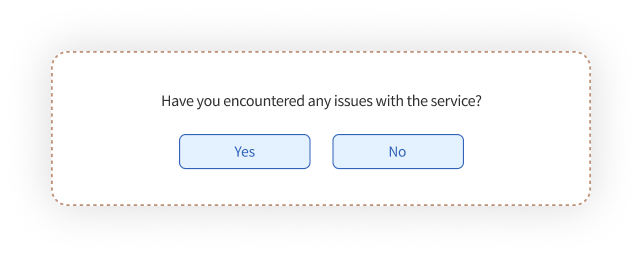 4. Hospitality Industry
4. Hospitality Industry
The goal of the hospitality industry is to gauge guest satisfaction and improve the overall experience that they have at a hotel, restaurant, or any other place. It helps assess different parameters like accommodation, amenities, facilities, service, and overall experience.
Here are some questions you can ask once your guests have arrived, during the stay, or after check-out:
- How clean and comfortable was your room/stay?
- Were the staff friendly and accommodating?
- Did the hotel meet or exceed your expectations for amenities and services?
- Would you recommend this hotel to others, and what could we do to improve your stay?
- Would you consider returning for another stay in the future?
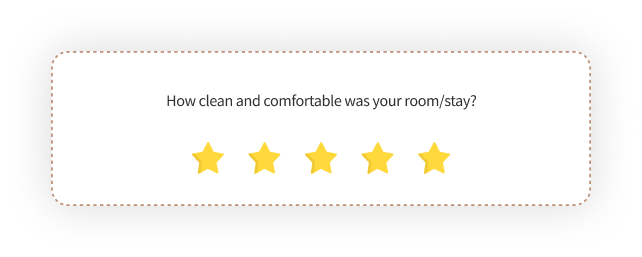
Channels to Use for Conducting Post-Purchase Surveys
1. Email Surveys
To effectively gather feedback from customers, it is important to send personalized post-purchase surveys directly to their inboxes. This can be easily achieved through email automation, ensuring that the survey is delivered in a timely manner after the transaction.
By utilizing email surveys, you can create a more personalized approach to collecting feedback. This allows you to tailor the survey questions specifically to each individual customer, based on their purchase history or preferences. By addressing customers by their names and referencing their recent purchases, you can create a more engaging and personalized survey experience.
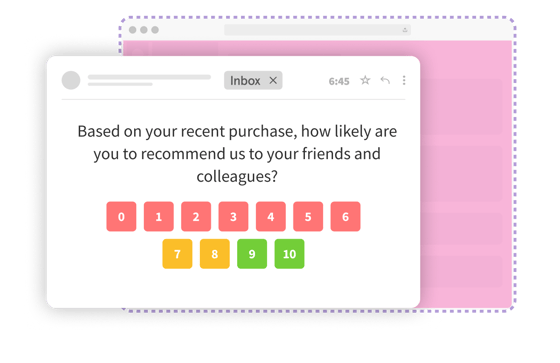
2. In-App Surveys
Capture feedback within your application or website for a seamless user experience in real-time. By implementing various feedback widgets, such as pop-up surveys, pop-over surveys, or embedded surveys, at strategic touchpoints throughout the user journey, you can effectively capture immediate post-purchase feedback. These widgets can be strategically placed after key interactions, such as completing a purchase, adding items to a cart, or signing up for a newsletter.
The advantage of using these feedback widgets is that they provide a convenient and non-intrusive way for customers to share their thoughts and opinions. Furthermore, these feedback widgets allow for targeted questioning based on the customer's specific purchase journey. By tailoring the survey questions to align with the various touchpoints throughout the user journey, you can gather more specific and relevant feedback.
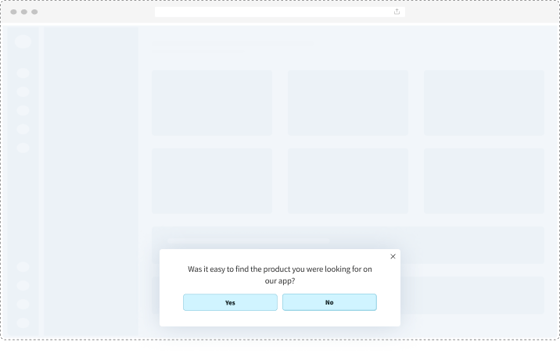
3. SMS Surveys
SMS surveys are particularly effective for short and urgent surveys. If you need immediate feedback on a particular aspect of your product or service, sending an SMS survey can quickly generate responses. This real-time feedback can help you make immediate improvements and address any concerns or issues that arise.
To ensure a seamless user experience, consider sending SMS surveys along with the e-bill of purchase. This way, customers can easily access the survey and provide feedback while their experience is still fresh in their minds. By integrating the survey into the transaction process, you can increase participation rates and gather feedback that is directly related to the customer's recent interaction with your brand. You can use any SMS survey software to do the same.
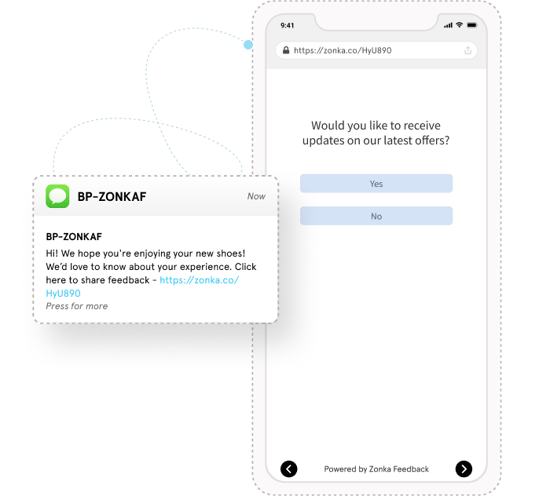
4. Social Media Surveys
Social media provides a unique opportunity to connect with your customers and gather their feedback in a more interactive and engaging way. By leveraging the interactive nature of social media, you can encourage participation and create a sense of community among your customers.
One effective strategy is to post post-purchase surveys directly on your social media platforms. This allows your customers to easily access and respond to the survey without leaving the platform. By incorporating eye-catching visuals and concise survey questions, you can capture their attention and encourage them to provide their feedback. Additionally, you can use features like polls or quizzes to make the survey more interactive and fun, increasing the likelihood of participation.
5. Website Surveys
Embedding post-purchase surveys using survey software on your website is a powerful strategy to gather valuable insights directly from users as they navigate your online platform. By strategically using website surveys, you can capture feedback on specific pages or features, allowing you to gain a deeper understanding of your customers' experiences and preferences.
When implementing website surveys, it's important to consider the timing and placement. You want to engage users at the right moment when their experience is still fresh in their minds. For example, if you have a specific page dedicated to customer support, you can embed a customer service survey at the end of that page to gather feedback on the effectiveness of your support team. Similarly, if you have a feature that allows customers to customize their orders, you can place a survey on that page to gather feedback on user-friendliness and satisfaction with the customization process.
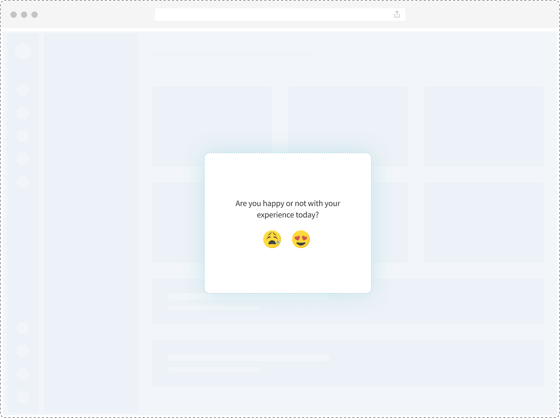
5. QR codes on receipts or packaging:
QR codes with post-purchase survey links on receipts or packaging are an innovative and effective way to gather feedback from customers. By including a QR code that leads directly to the survey, you provide a convenient and seamless method for customers to share their thoughts and opinions.
Customers can simply scan the code using their smartphone camera, and it will automatically redirect them to the survey. In addition to being convenient, QR codes can also be visually engaging. By incorporating your business logo design or a catchy design into the QR code, you can make it more visually appealing and eye-catching. This can help attract the attention of customers and encourage them to scan the code and participate in the survey.
Furthermore, QR code surveys on receipts or packaging can offer incentives for participation. For example, you can include a message on the receipt or packaging that states, "Scan the QR code to take our survey and receive a discount on your next purchase!" This provides customers with an immediate benefit for completing the survey, making them more likely to engage and provide valuable feedback. The same strategy can be used while working with business partners. Make use of dealer incentive program to turn transactional relationships into long-term valued partnerships.
Best Practices for Creating Post-Purchase Survey
To optimize the implementation of post-purchase surveys and maximize their effectiveness and participation, it is crucial to take actions that can improve response rates and gather valuable insights. Consider the following proactive approach to enhance your post-purchase survey response rates and outcomes.
1. Tailor Survey Based on Specific Order
Customizing each respondent's post-purchase survey experience based on their order details can help gather more targeted and actionable customer feedback. For example, you can request your customers to input order numbers, based on which you can tailor the survey to show the relevant survey questions for the specific product they ordered.
- How to implement tailor a survey to get personalized feedback from customers?
- Determine the variables (order number, product name, etc.) you want to use for tailoring the survey.
- Create a survey structure that accommodates different branching points based on order-specific variables.
- Customize question paths and direct your customers to particular questions related to the order-specific variables.
2. Personalize the Survey Based on Your Customers
To gather genuine customer feedback, personalize the post-purchase survey by categorizing customers into specific groups. Tailor the survey questions to each group, focusing on discovering how new customers found the brand and their satisfaction with their first purchase.
For repeat customers, skip the discovery question and measure their likelihood to recommend the brand based on their overall experience, providing insights into loyalty and advocacy.
Presenting them with surveys that align with their interests or characteristics creates a more personalized and meaningful interaction, resulting in higher engagement and more insightful feedback.
3. Display at an Appropriate Time
To capture accurate feedback and ensure its relevance, choose the appropriate time to show the post-purchase survey to customers.
For example, imagine a customer has just received their online order and is excited to unbox the product. At that moment, if they are prompted with a survey to provide feedback on the packaging quality, delivery experience, and overall satisfaction, they are more likely to provide specific and detailed responses as their emotions and impressions are fresh, leading to a higher quality of feedback. On the other hand, if the survey is displayed days or weeks later, the customer's memory may have faded, and their responses may be less accurate and less valuable for improving the customer experience.
By timing the survey appropriately, you can gather feedback that reflects the customer's direct experience, leading to actionable insights and better opportunities for addressing any concerns or areas of improvement.
4. Add Closed & Open-Ended Questions
It is essential to include both open-ended and close-ended questions in a post-purchase survey to gather comprehensive, balanced, and meaningful feedback from customers.
While closed-ended questions provide structured and quantitative data, allowing for easy analysis and comparison, open-ended questions encourage customers to provide detailed and qualitative feedback in their own words.
Here are some closed-ended questions and open-ended questions that you can add to the post-purchase survey:
Closed-ended Questions:
- On a scale of 1 to 5, how satisfied are you with the quality of the product you purchased?
- Which of the following factors influenced your purchase decision the most?
- Price
- Product Features
- Brand Reputation
- Customer Reviews
- Other
- Would you recommend our product to others? (Yes/No)
Open-Ended Questions:
- Please share any suggestions or improvements you have for our product or service.
- Describe your overall experience with our customer support team.
- Is there anything else you want us to know about your purchase experience?
5. Create Device Responsive Surveys
Creating device-responsive post-purchase surveys is vital for an effective and user-friendly feedback collection process. By optimizing your survey for various devices, you improve participation rates and reach a broader customer base.
You can use a responsive design that adjusts to different screen sizes with reduced questions and clear instructions. Before sharing the survey, ensure to test on multiple devices and browsers so that your customers do not face any friction while attempting the post-purchase survey.
6. Place the Post-Purchase Survey Right
The right placement of a post-purchase survey is crucial to make it more effective and garner responses. Ideally, since a post-purchase survey comprises a few questions, placing it right on the after-purchase thank-you page is the most effective strategy. A full-page pop-up form, slider pop-up, or simple banner form asking for their feedback is recommended.
Implementing post-purchase surveys is a powerful strategy for gathering valuable customer feedback and improving the overall customer experience. By designing effective surveys, measuring key metrics, and leveraging feedback for improvements, you can enhance customer experience, foster loyalty, and stay ahead in a competitive marketplace.
Elevate Your Post-Purchase Strategy with Zonka Feedback
Ready to revolutionize your post-purchase feedback strategy? Schedule a demo to explore Zonka Feedback's Post-Purchase Surveys. This software not only facilitates feedback collection but also enables you to take prompt action and effectively close the feedback loop. By leveraging such a customer feedback tool, you can elevate your post-purchase customer feedback process and deliver an exceptional customer experience.
Uncover actionable insights, enhance customer satisfaction, and propel your business toward lasting success. Sign up now and embark on a journey of continuous improvement!



.png)


.jpg)
.jpg)
.jpg)

.jpg)
.jpg)
